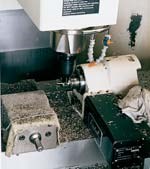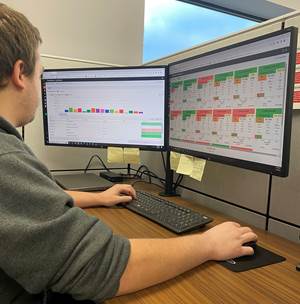Aviation Component Supplier Cuts Setup Time With Productivity Partnership
This shop turned to a tool supplier to help cut milling time on one alloy steel hydraulic body by 63 percent. The success led to a broader Productivity Improvement Program that identified some $87,000 in potential annual savings, and ultimately to a $600,000 payoff by introducing a quick-change modular tooling system.
Share




Hwacheon Machinery America, Inc.
Featured Content
View More




For a busy aircraft components manufacturer milling and turning short runs of precision parts, shorter cycle times and quicker tool changes mean greater profitability. Crissair, Inc. (Palmdale, California) turned to tool supplier Sandvik Coromant (Fair Lawn, New Jersey) to help cut milling time on one alloy steel hydraulic body by 63 percent. The success led to a broader Productivity Improvement Program that identified some $87,000 in potential annual savings, and ultimately to a $600,000 payoff by introducing a quick-change modular tooling system.
Crissair has produced precision fluid control components for civil and military aircraft since 1954. Components are machined from 17-4, 15-5, and other alloy steels, 300 Series stainless, Inconel, titanium and aluminum. The company has developed more than 10,000 designs for its customer base, of which 3,500 are still active. "Since most items are produced in short runs of 15 to 30 pieces, short cycle times and fast changeovers from one part to another are essential to profitability," says John Semione, general manager.
One common series of hex-shaped hydraulic components includes sizes from 0.2 inch diameter by 0.3 inch long to 3 inches diameter by 18 inches long. The 15-5 alloy steel material is milled on the face and outside diameter to ±0.005 inch on the hex dimensions. Finishes must be held to 100 microinches or better. Orders for the most popular sizes are 400 to 500 parts a year.
Cycle time on one of the larger fittings was nearly 20 minutes on Fadal CNC milling machines using end mills with conventional carbide inserts. "We wanted something to speed up those milling operations," recalls Larry Moore, machine shop manager. Discussions with Sandvik Coromant representative Martin Morris resulted in trials of the Sandvik CoroMill 390 milling cutter with grade GC1025 carbide inserts.
Machine speeds and feeds using the original end mill and inserts were 2,300 rpm and 8 ipm. The ¾ inch diameter CoroMill 390 enabled operators to run the same parts at 5,000 rpm and 60 ipm. "We saw an increase in material removed by our Fadals," recalls Mr. Moore. Cycle time for the large hydraulic component fell from 20 minutes to 7.5 minutes. In addition, the milling operation that once required costly coolants could now be run dry.
The tooling success in the milling operations led Crissair to consider changes in its turning cell with four Okuma and Ikegai CNC lathes. In the Crissair facility, the Productivity Improvement Program started with an audit of cycle times and machining data in cell one.
With the existing cutting inserts, one part-off operation on a stainless steel hydraulic body required 26.1 seconds. Surface speed was 100 sfm and feed was 0.0015 ipr. With a switch to Sandvik's Grade GC2135 inserts, machine operators more than tripled speed to 325 sfm and increased feed 2.3 times to 0.0050 ipr. Cutting time per component fell from 20 seconds to less than 2 seconds. With non-cutting time unchanged, overall cycle time fell 70 percent, from 26.1 seconds to just 7.86 seconds. The cumulative savings in time and tools cut machining cost per component 56 percent. Over a typical annual run of just 145 parts, savings would amount to $73.16. Similar savings were achieved in other operations.
Though the savings on individual part runs were small, their cumulative value was significant. The Productivity Improvement Program identified potential savings totaling $87,797 over a year from all the operations in Crissair cell one. Sandvik representatives provided training for Crissair machine operators to implement the changes.
As the productivity changes were implemented, Mr. Semione asked Mr. Morris and local Sandvik supplier Phil Canipe from BC Tool and Carbide about modular tooling to improve job changeovers. "We do a lot of short-run jobs," explains Mr. Semione. "Setup time is a real cost driver. If we amortize the cost of setup over just 15 parts, it becomes a significant factor." Mr. Morris and Mr. Canipe recommended that Crissair evaluate the Sandvik Coromant Capto modular tooling system and developed a training program to maximize return on investment.
Capto quick-change tooling uses a tri-lobed coupling to create an extremely stable joint. The self-centering coupling has a pre-tensioned joint interface that develops several tons of clamping force. A quick turn on an Allen key releases and re-clamps the holder with 0.000080-inch repeatability, radially and axially. The modular holder enables machine operators to replace tools quickly and return them to accurate cutting positions. It also eliminates hit-or-miss adjustments and costly scrap on setup.
Changeover on Crissair's CNC lathes was typically a 5- to 6-hour job. "We were using old drill holders with blocks and bushings, and the whole thing was very time consuming and very imprecise," says Mr. Moore. "First, you have to find a drill and bushing to go in that holder, then put them in and use a microscope to get the location to program the CNC."
Capto toolholders eliminated both the hunt for bushings and the adjustments to center each tool. "We easily cut our changeover time in half," says Mr. Moore. "Our target is now 2 hours or less."
Mr. Semione adds, "We have found that if we really focus on a job and have all the tools prepared up front, we can set up most jobs in under 2 hours. Our goal by close of 2002 is to average under 1 hour and have modular tooling on each CNC lathe," he explains. Using modular tooling, annual cost savings is more than $600,000.
Related Content
Broaching Tool Technology For Lathes Used to Slot Inconel Parts
This shop finds value in using an indexable-insert-style broaching tool to create blind-hole slots in heat-treated Inconel aerospace parts on a CNC lathe.
Read More5 Tips for Running a Profitable Aerospace Shop
Aerospace machining is a demanding and competitive sector of manufacturing, but this shop demonstrates five ways to find aerospace success.
Read MoreHow to Meet Aerospace’s Material Challenges and More at IMTS
Succeeding in aerospace manufacturing requires high-performing processes paired with high-performance machine tools. IMTS can help you find both.
Read MoreMachine Monitoring Boosts Aerospace Manufacturer's Utilization
Once it had a bird’s eye view of various data points across its shops, this aerospace manufacturer raised its utilization by 27% in nine months.
Read MoreRead Next
Building Out a Foundation for Student Machinists
Autodesk and Haas have teamed up to produce an introductory course for students that covers the basics of CAD, CAM and CNC while providing them with a portfolio part.
Read More5 Rules of Thumb for Buying CNC Machine Tools
Use these tips to carefully plan your machine tool purchases and to avoid regretting your decision later.
Read MoreRegistration Now Open for the Precision Machining Technology Show (PMTS) 2025
The precision machining industry’s premier event returns to Cleveland, OH, April 1-3.
Read More

































.png;maxWidth=300;quality=90)















